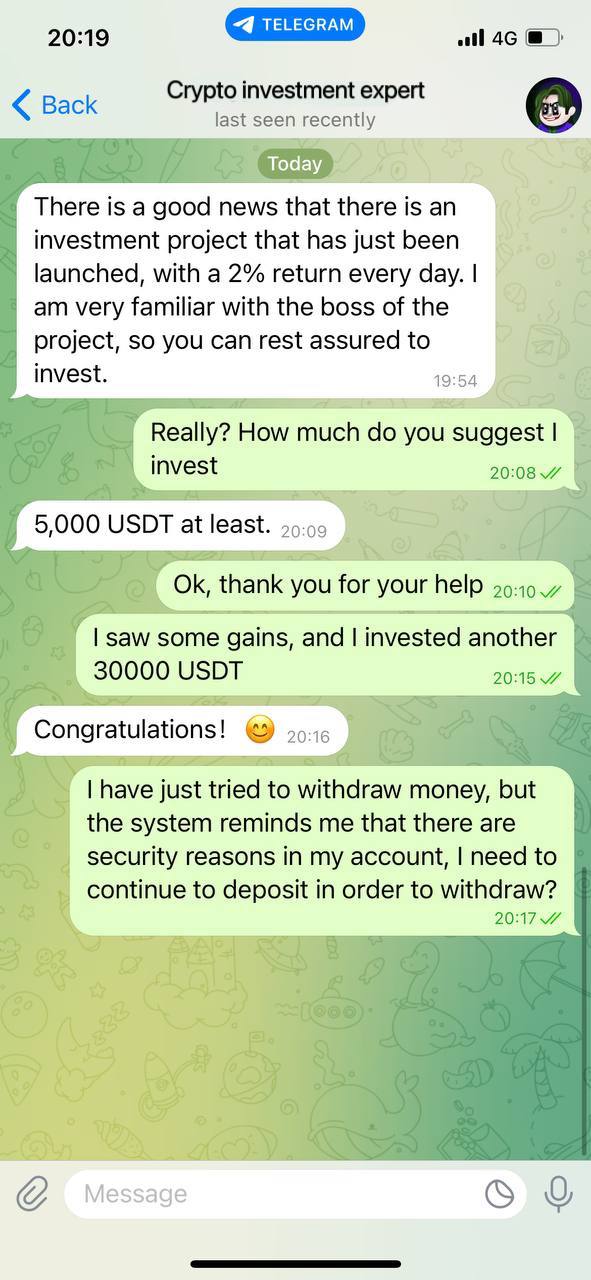Key takeaways
Fake investment scams promise high returns to lure victims into giving up their money.
Typically, scams take place in four stages: find a victim, gain their trust, encourage them to take action, then close the trap.
Report any scam attempts against you to the relevant authorities, change compromised passwords and freeze all your accounts if you have already transferred money.
Protect yourself from crypto scams by learning how to identify and avoid fake investment scams. Keep reading this week’s “How to Survive Scams” article to find out more!
At first glance, these so-called crypto financial advisors, employees of large financial companies or even celebrities, inspire trust, and the promised returns are very high, all with a minimal level of risk or effort: but this are indeed investment scammers.
Investment scams can take many forms, but their mechanism remains the same: promising victims exorbitant returns, then disappearing into thin air with their money. Remember one thing: if it seems too good to be true, it probably is. Don't fall into the trap!
First, let’s look at how an investment scam usually works.
A scam in four steps
1. Find a victim
Scammers often use popular social networks such as Facebook, Instagram or Twitter to find potential targets. They then enter into contact with the latter by posing as an investment manager wishing to provide advice or a wealthy Internet user who has “went to the wrong recipient” when sending their message.
However, not all fake investment scams are so direct: some scammers impersonate brands or personalities known on social networks, such as Elon Musk, to promote their services. These ads link to a professional-looking website designed to make visitors feel confident.
2. Gain his trust
The scammer attempts to gain confidence in his target by sending him testimonials from satisfied investors and users as well as fabricated reports of winnings. Some scammers even go so far as to talk about topics like physical and mental health, and even members of the victim's family.
3. Encourage him to take action
After spending some time pretending to be the target's "friend" (and brainwashing them), the scammer manages to gain their trust and steers the conversation toward investments and high monetary gains.
Our team has also already observed scammers encouraging the use of fake investment software where everything is false: prices, investment returns and crypto listings. Some go even further and create an upward movement with completely invented charts to encourage investors to deposit money.
4. Close the trap
The deal is concluded, and the investor can in theory finally benefit from his new gains. But suddenly, any withdrawal becomes impossible, or the account has been “closed”. The “investment manager” becomes more distant, then eventually stops responding to messages.
The target is now a victim in its own right; the scammer may even try to extract additional money to allow a withdrawal.
Two examples in action
Here are two examples of real-life fake crypto investment scams, which we hope will help users more easily identify the methods, mechanisms and approaches used by scammers.
Example #1: The Crypto Financial Advisor
A user, whom we will call Mark, fills out an online form asking questions about his habits and opinions regarding cryptos. He then receives a prospecting call from a scammer pretending to be a financial advisor.
Over the next few months, Mark and the advisor developed a professional relationship, communicating and exchanging information every day: the scammer eventually gained Mark's trust.
One day, the scammer encourages Mark to invest through a platform that generates a daily return of 2%. Mark blindly trusts his new “friend” and deposits 5,000 USDT.
Mark's money generates the promised return over the next few days, and the scammer encourages him to invest a larger sum: Mark accepts and deposits 30,000 USDT. A week later, Mark realizes he has been scammed.
Example #2: Fame
A user, whom we'll call Lucy, clicks on a link to "Elon Musk's quantum AI trading platform" on Facebook. All he apparently needs to do is deposit his cryptos, and an AI will do the trading for him.
After contacting the “quantum AI trading platform”, Lucy makes a first deposit of $250. Trading begins, and she quickly accumulates gains: Lucy is convinced that by “investing” $5,000 in the platform, she will make even greater gains, and takes action. Lucy realizes she has been scammed when her withdrawal attempts are blocked due to an "anti-money laundering (AML)" policy, which requires payment of fees of up to 30% to unlock the withdrawal.
How to protect yourself from fake investment scams?
Conduct your own research (DYOR)
All crypto projects must be able to present a whitepaper that explains the mechanisms and tokenomics. If someone encourages you to invest in a project whose whitepaper has no logic, or worse yet, is non-existent, be wary.
Check the background of the company, its owners, directors and employees, or at least do a quick Google search and use common sense.
Finally, ask yourself if the project is run by a real team, what problem is it trying to solve, and if there is a community of legitimate users supporting the project or product.
Don't assume authenticity
Websites, advertisements or social media posts are not reliable indicators of a real investment opportunity, even if they look professional. Scammers often impersonate trusted brands like Binance or well-known people to legitimize their scams.
Beware of high returns
No financial investment can guarantee any future return. No one, not even an algorithm or a project, is able to accurately predict market movements, and all promises of guaranteed returns are red flags, especially those like “3% returns per day” . Do not relax your vigilance, even if the announced figure seems low and plausible: 3% per day corresponds to a total of 1,095% per year, which is highly improbable.
Refuse unsolicited investment proposals
The so-called investment expert or hot single who sent you this message is probably a scammer. You're Nothing Special: Professional scammers chat and flirt with hundreds, if not thousands, of targets every day.
Even if only one person makes an investment, their time is not wasted. Don’t let anyone pressure you into making an investment decision.
Protect your personal information
Always verify the identity of the person talking to you about investments on an official website or social media account, and never disclose your personal information or account details to anyone.
If you receive a message asking you to reveal sensitive information, for example your 2FA codes or passwords, block this contact and report it immediately to the relevant authorities.
If you have been scammed
There's nothing to be ashamed of, it can happen to anyone. Being the victim of a crypto scam can be a huge blow to morale, but it’s crucial to respond quickly.
If the scam took place on social media, report it to the platform in question and local authorities.
Change your passwords and freeze your financial accounts if you have already made a payment or transfer using a debit or credit card. Additionally, crypto scammers often resell the personal information they steal to other criminals: be sure to change all your usernames and passwords to avoid further damage.
Do not trust strangers who contact you immediately after the scam, especially if they offer to get your money back: this may be another scam, whether or not related to the one you have just suffered, which will, for example, ask you to pay fees to get your money back.
If your Binance account is compromised, contact us immediately: How to report a scam to Binance customer service.
For more information
(Academy) 8 Common Bitcoin Scams and How to Avoid Them
(Blog) How to Survive Scams: The Complete Guide to the Most Common Crypto Scams
(Blog) Binance partners with law enforcement to launch joint anti-scam campaign
Disclaimer and Risk Warning: This content is presented to you “as is” for general information and educational purposes only, without representation or warranty of any kind. It should not be construed as financial advice, nor as a recommendation to purchase a specific product or service. Prices of digital assets can be volatile. The value of your investment may go down as well as up and you may not get back the amount you invested. You are solely responsible for your investment decisions and Binance is not responsible for any losses you may incur. This does not constitute financial advice. Please see our Terms of Use and Risk Disclaimer for more information.











